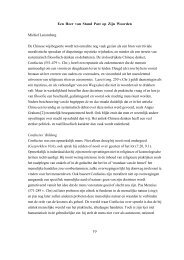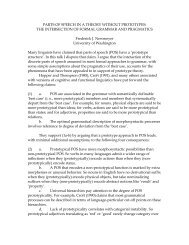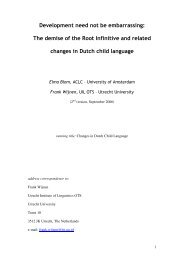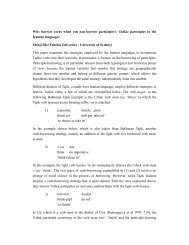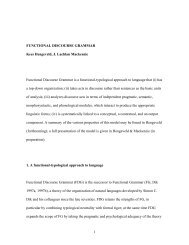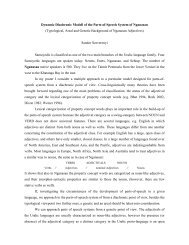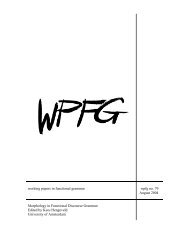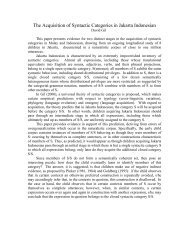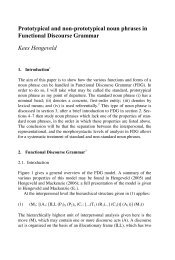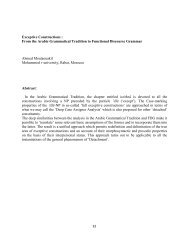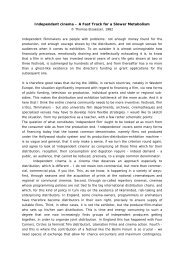The argument structure of deverbal nouns in Brazilian Portuguese
The argument structure of deverbal nouns in Brazilian Portuguese
The argument structure of deverbal nouns in Brazilian Portuguese
Create successful ePaper yourself
Turn your PDF publications into a flip-book with our unique Google optimized e-Paper software.
followed <strong>in</strong> (46a) and (47a). In (48), on the other hand, they work simultaneously to<br />
produce both zero anaphora: the one referr<strong>in</strong>g to caça ‘hunted’ is motivated by<br />
semantic predeterm<strong>in</strong>ation; the other, referr<strong>in</strong>g to homens pré-históricos ‘prehistorical<br />
men’, is pragmatically motivated.<br />
As po<strong>in</strong>ted out before, <strong>deverbal</strong> <strong>nouns</strong> have a hybrid nature, given that they<br />
may refer to second- or third order entities; <strong>in</strong> such cases, however, they have their<br />
structural expression modeled after prototypical <strong>nouns</strong>, that is, <strong>nouns</strong> referr<strong>in</strong>g to firstorder<br />
entities. This raises the question <strong>of</strong> how they may be represented <strong>in</strong> the FDG<br />
framework.<br />
Mackenzie (2004) argues that operators <strong>of</strong> identification and specification<br />
become more accessible as the nom<strong>in</strong>al status <strong>of</strong> the embedded predication <strong>in</strong>creases.<br />
He also adds that <strong>in</strong>def<strong>in</strong>ite operators may act on the Referential Subact, as seen <strong>in</strong><br />
w<strong>in</strong>n<strong>in</strong>g this battle is a w<strong>in</strong>n<strong>in</strong>g <strong>of</strong> all battles and there won't be any w<strong>in</strong>n<strong>in</strong>g <strong>of</strong> hearts<br />
and m<strong>in</strong>ds (Mackenzie 2004). Thus, to do justice to the ambiguous character <strong>of</strong> the<br />
nom<strong>in</strong>alizations, the most plausible explanation is to consider that, follow<strong>in</strong>g<br />
Mackenzie (2004), their nom<strong>in</strong>al half forces us to represent them as Referential<br />
Subacts and their verbal half to represent them as Ascriptive Subacts. By way <strong>of</strong><br />
illustration, consider the two-place predicate destruição ‘destruction’ <strong>in</strong> (43b),<br />
repeated here as (49a) for convenience.<br />
(49)a. A destru-ição de Bagdá pel-o exército americano<br />
the.F destroy-NMLZ <strong>of</strong> Baghdad by-the.M army American<br />
caus-ou a morte de civi-s.<br />
cause-IND.PRF.3SG the.F death <strong>of</strong> civilian-PL<br />
‘<strong>The</strong> destruction <strong>of</strong> Baghdad by the American Army caused the death <strong>of</strong> civilians.’<br />
For the sake <strong>of</strong> simplification, let us take <strong>in</strong>to account only the underly<strong>in</strong>g<br />
representation <strong>of</strong> an embedded <strong>deverbal</strong> noun function<strong>in</strong>g as the subject <strong>of</strong> the ma<strong>in</strong><br />
predication, as <strong>in</strong> (49a), <strong>in</strong> order to account for the mentioned hybrid categorial nature<br />
<strong>of</strong> <strong>deverbal</strong> <strong>nouns</strong>. Follow<strong>in</strong>g Mackenzie (2004), 11 I would like to suggest that<br />
<strong>deverbal</strong> <strong>nouns</strong> represent a Subact <strong>of</strong> Ascription at the Interpersonal Level, embedded<br />
<strong>in</strong> a Subact <strong>of</strong> Reference, as represented <strong>in</strong> (49b); at the Representational Level they<br />
represent a relation between two referential entities (Bagdá and exército americano),<br />
as can be seen <strong>in</strong> (49c).<br />
A destruição de Bagdá pelo exército americano<br />
(49)b (R1 [(T1) (R2) (R3) ] (R1))<br />
c (e1 [(f1: destruiçãoN (f1)) (x1: exército americano(x1))Ag (x2: Bagdá (x2))Pat ] (e1))<br />
My <strong>in</strong>terpretation differs from the one suggested by Mackenzie (1996) with<br />
regard to the question <strong>of</strong> whether the <strong>argument</strong> <strong>structure</strong> is preserved or not dur<strong>in</strong>g the<br />
process <strong>of</strong> Formulation. I take the position that the way the <strong>argument</strong>s <strong>of</strong> embedded<br />
predications are expressed depends on pragmatic and semantic motivations as<br />
discussed earlier. <strong>The</strong>se two motivations are directly reflected at the Structural Level,<br />
s<strong>in</strong>ce they are responsible for trigger<strong>in</strong>g <strong>argument</strong> expression either as zero anaphora<br />
or as full lexemes.<br />
Thus, to do justice to the hybrid character <strong>of</strong> <strong>deverbal</strong> <strong>nouns</strong>, I argue that the<br />
morphosyntactic expression must be represented as two layers, which I would call<br />
<strong>in</strong>ternal syntax and external syntax, follow<strong>in</strong>g Haspelmath’s (1995) representation <strong>of</strong><br />
28




